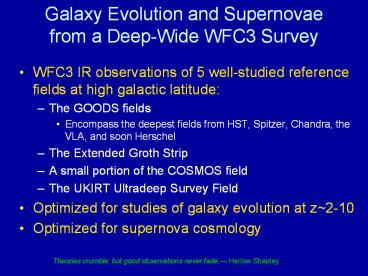Galaxy Evolution and Supernovae from a Deep-Wide WFC3 Survey - PowerPoint PPT Presentation
1 / 17
Title:
Galaxy Evolution and Supernovae from a Deep-Wide WFC3 Survey
Description:
Galaxy Evolution and Supernovae from a Deep-Wide WFC3 Survey WFC3 IR observations of 5 well-studied reference fields at high galactic latitude: – PowerPoint PPT presentation
Number of Views:79
Avg rating:3.0/5.0
Title: Galaxy Evolution and Supernovae from a Deep-Wide WFC3 Survey
1
Galaxy Evolution and Supernovae from a Deep-Wide
WFC3 Survey
- WFC3 IR observations of 5 well-studied reference
fields at high galactic latitude - The GOODS fields
- Encompass the deepest fields from HST, Spitzer,
Chandra, the VLA, and soon Herschel - The Extended Groth Strip
- A small portion of the COSMOS field
- The UKIRT Ultradeep Survey Field
- Optimized for studies of galaxy evolution at
z2-10 - Optimized for supernova cosmology
Theories crumble, but good observations never
fade. Harlow Shapley
2
Merger of two similar proposals
- Sandy Fabers team proposed a wedding cake
strategy with 2-orbit depth in the three
non-GOODS fields, and 50 of GOODS to 15-orbit
depth. - Our team proposed to cover both GOODS fields to
intermediate depth and to measure supernovae
spectra and light curves. We also proposed UV
observations for GOODS-N. - The TAC liked the wedding cake, the supernova
followup and the UV observations. - Teams were merged and told to try to preserve
these features.
3
90 Co-investigators
4
Supernova Cosmology
- Refine the only constraints we have on the time
variation of w, on a path to more than doubling
the strength of this crucial test of a
cosmological constant by the end of HSTs life.
5
Supernova Cosmology
- Obtain a direct, explosion-model-independent
measure of the evolution of Type Ia supernovae as
distance indicators at z gt 1.5, independent of
dark energy.
6
Supernova Cosmology
- Provide the first measurement of the SN Ia rate
at zgt1.5 to distinguish between prompt and
delayed SN Ia production and their corresponding
progenitor models.
7
Supernova Cosmology
- Refine the only constraints we have on the time
variation of w, on a path to more than doubling
the strength of this crucial test of a
cosmological constant by the end of HSTs life.
8
Supernova Cosmology
9
Cosmic Dawn
- Greatly improve the estimates of the evolution of
stellar mass, dust and metallicity at z 4-8 by
combining WFC3 data with very deep Spitzer
observations.
10
Cosmic Dawn
- Improve by 10x the constraints on the bright
end of the luminosity function at z7 and 8, and
make z6 measurements robust using proper 2-color
Lyman break selection.
11
Cosmic Dawn
- Measure fluctuations in the near-IR background
light, at sensitivities sufficiently faint and
angular scales sufficiently large to constrain
re-ionization models.
- Extragalatic background
- Integrated galaxy counts below previous detection
limits form a lower EBL bound - Gamma-Ray bursts (e.g Aharonian et al. 2005) form
upper bound - Direct detections are difficult due to the EBLs
faint intensity - Detections currently conflict
Bock et al. 2006
12
WFC3 Fluctuation Measurements
- The large angle (? 1/30 ) peak (green curve)
is a linear-theory prediction of clustering of
reionization sources. - Small scale power is sensitive to the slope and
normalization of the luminosity function. - large area surveys with WFC3 can (barely) reach
large angle peak
Reionization Simulation from Trac and Cen 2007
Large ? ????? ????? Small ?
13
Cosmic high-noon
- Test models for the co-evolution of black holes
and bulges via the most detailed census of
interacting pairs, mergers, AGN, and bulges,
aided by the most complete and unbiased census of
AGN from Herschel, improved Chandra observations,
and optical variability.
14
Cosmic high-noon
- Detect individual galaxy subclumps and measure
their stellar mass, constraining the timescale
for their dynamical-friction migration to the
center leading to bulge formation. - Reveal the presence of fully formed passively
evolving bulges out to z gt 3, measure the
bulge/disk ratio, and provide constraints on the
relative ages of the bulge and disk populations. - Measure the rest-frame optical morphologies of
passive galaxies up to z2 and beyond, and
combine with ACS data to quantify UV-optical
color (age) gradients.
15
Cosmic variance
16
Observing strategy
- Wide fields
- 750 sq. arcmin
- 2/3 orbits J (debating F125W vs. F110W)
- 4/3 orbits H (F160W)
- Half the GOODS area covered this way
- GOODS Deep
- 130 sq. arcmin
- 12 orbit depth 444 in F105WF125WF160W
- At least 12 orbits new ACS F814W
- UV (GOODS-N)
- 70 sq. arcmin
- Primary science is Lyman-escape fractions at
z2.5 - 31 ratio in F275WF336W leaning toward binning
2x2
17
Technical Issues
- We need to reprocess and stack all the existing
ACS data on these fields (for high-z galaxies) - With better geometric distortion corrections and
astrometry than the original GOODS stacks - With CTE corrections (Anderson algorithm?)
- Need alignment to WFC3 to within 0.1 pixel
- Correcting crosstalk for the EBL fluctuations
project - We are looking closely at image subtraction and
galaxy morphology versus number size of dithers - We need to worry about scattered earthshine for
the CVZ orbits - Persistence, blobs, etc. will be a challenge for
the EBL fluctuations measurement.































